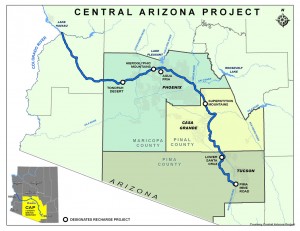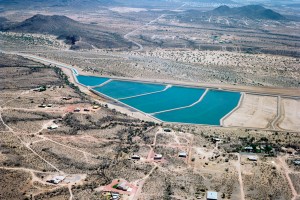In my last Post, I wrote about how a part of California’s water future is inextricably linked to the health of the Colorado River’s water supply. As I mentioned, the Colorado River currently is enjoying the benefits of a slightly above average snowpack in the mountains that feed the River. Further, the Colorado River has two of the largest reservoirs in the West in Lake Powell and Lake Mead. These two reservoirs help to stabilize the water reserves for the states that rely on the River’s bounty and aid in planning for future drought years. But lately, both scientists and policymakers have grown increasingly concerned that we will not be able to rely on the Colorado to supply as much water in the future. One state that these decreased water supplies could affect critically is Arizona. In this piece, I will discuss the challenges that Arizona faces from dwindling Colorado River supplies, and highlight the steps that the state is taking to address these long-term supply challenges.
Arizona, like many states along the Colorado, relies on the River’s bounty for a significant portion of its water resources. Much like the Colorado River Aqueduct supplies water so parts of Eastern and Southern California, the Central Arizona Project collects the state’s allocation of Colorado River water and delivers it to cities as far away as Tucson (please see the illustration below for a detailed map of the system). The systems of canals and aqueducts can deliver up to 1.5 million acre feet of water annually off of the Colorado River. As you can probably imagine, the amount of water flowing through the Colorado River relies almost entirely on the snowfall in the Rocky Mountains. As I mentioned in my last piece, the weather patterns this winter were not kind to the Sierra Nevada Mountains in California, but the Rockies experienced much more snow. The Central Arizona Project media center reported on April 24th that for the first time since 2011, the snowpack in the Rocky Mountains came in slightly above average. In the short-term, this should bode well for Arizona as well as all other states that rely on the Colorado River. However, the longer-term supply picture looks less secure.
An issue that Arizona faces that may be less apparent is that the state will be the first along the Lower Colorado River Basin (Arizona, California and Nevada) to suffer cutbacks on water supplies. Not all water rights are created equally – there are both “senior” and “junior” water rights. California for example holds water rights to the Colorado River that are senior to Arizona’s water rights. A landmark agreement in 2007 called the Shortage Sharing Agreement outlined the actions that the Lower Colorado Basin states would take in the event of a prolonged water shortage. The shortage measures will go into effect if the Bureau of Reclamation 24 Month Studies forecast that the level of Lake Mead as of Jan 1 of a year is below 1075 feet. (Please check out Stratecon’s full discussion of the topic at the recently-launched www.journalofwater.com ) The Level of Lake Mead for Jan 2014 was 1,108.8 feet. The most recent monthly forecast (Feb 2014) for 1,088 feet for Jan 2015 and 1084 feet for Jan 2016. While BOR forecasters do not expect that we will experience shortage triggers in the next few years, the trend is still forecasted to move downwards. As such, Arizona’s policymakers cannot be flat-footed on planning for future water supply concerns, as they will be the first in the area to experience cutbacks. Further, both the citizens and end users of water in Arizona cannot get complacent and assume that water supplies from the Colorado River will be reliable in the long-term. While water supply challenges do not seem dire in the short-term, the long-term outlook paints a murkier picture.
While the current water supplies from the Colorado River look sufficient for the next few years, supplies further into the future are not nearly as secure. In January, an Arizona Department of Water Resources report concluded that the state must find new sources of water in the future to keep up with growing demands on water resources. The agricultural industry in Arizona is vibrant and adds on average $9.2 billion annually to the state’s economy. According to that same report, agriculture uses 47% of Maricopa County’s water (the county includes greater Phoenix), and agriculture uses an astonishing 96% of the water in neighboring Pinal County. Further population growth will also put continued pressure on water supplies. According to the New Phoenix Times, Maricopa County in 2013 experienced the second highest growth rate by county in the nation, second only to Harris County, Texas. Both of these trends will continue to put strains on the state’s water supplies. So what can planners do?
Much like other Western states, Arizona can face years of drought in between rainy seasons. Arizona established its Water Banking Authority in 1996 to store excess Colorado River water during rainy seasons. Water banking takes excess water during rainy years and stores it in underground aquifers. During dry years, that same water Arizona stored can be drawn back up and used to slake the state’s thirst. Both Rod Smith and I on a few occasions have pointed out the need in California for more water storage, and it is a positive for Arizona that the state has taken concrete steps to address this challenge. Also, despite the fact that Arizona is landlocked, it is looking into desalination strategies. In the state’s recent water report entitled A Strategic Vision for Water Sustainability, Arizona is considering working with California to fund desalination projects. Arizona will give California funding for desalination plants in exchange for some of California’s allocation from the Colorado River. Conservation along with storage will also be key to the long-term sustainability of the state’s water supplies.
As the droughts in the Western US get longer and more severe, states will have to do more to plan for long-term droughts. Arizona in particular will have to keep a close eye on its water supply from the Colorado River. Despite the challenges of dwindling water supplies that Arizona faces, a combination of water storage and conservation can go a long way to securing the state’s water future.


